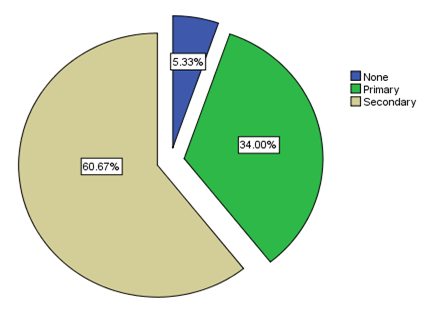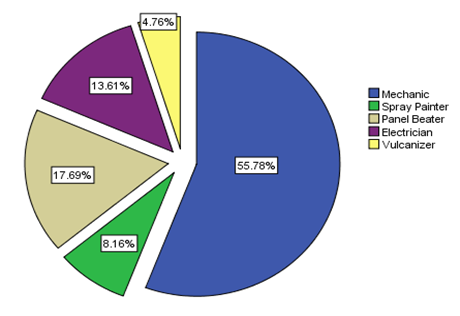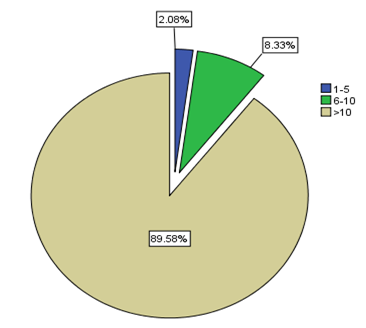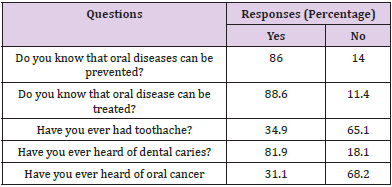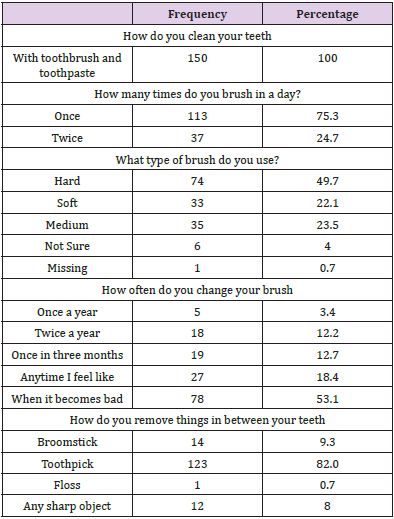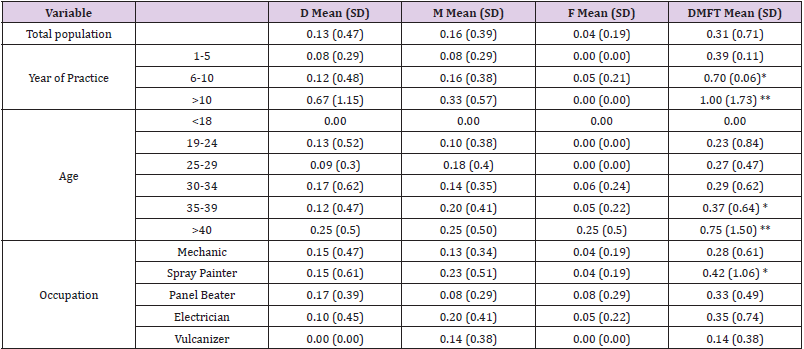ABSTRACT
Oral diseases are becoming increasingly prevalent in low- and middle-income countries, and health education is widely accepted as a suitable approach for oral disease prevention. Oral health is a key indicator of overall health, well-being and quality of life. Therefore, the present study assessed oral health knowledge, attitude, practices and utilization of dental services amongst automobile technicians in Benin city. This study included one hundred and fifty (150) automobile technicians geographically dispersed as follows; Oredo local government covering thirteen (13) automobile workshops, Egor local government covering ten (10) mechanic workshops, and Ikpoba-Okha local government covering fifteen (15) automobile workshops all in Benin City. All the respondents were requested to answer a self-administered questionnaire. The questionnaire included 22 items in three sections. The first section was about demographical data. The second section assessed oral health knowledge, and the third section evaluated the practice of oral health preventive measures. The DMFT score of the samples were determined based on the results of clinical examination and calculation of the number of decayed (D), filled (F), and missed (M) teeth due to caries. Assessment of oral health knowledge of the participants revealed that the participants demonstrated adequate knowledge on the prevention and treatment of oral diseases as well as knowledge about dental caries. however, it was observed that 68% of the participants had no knowledge about oral cancer which perhaps could be attributed to their educational qualification. The study observed an adequate oral health practice amongst the participants; however, an inadequate utilization of dental services was also observed. DMFT index was found to be associated with years of practice and age. Therefore, the need for an improved sensitization and education on the status of good oral health practices.
Keywords: Oral Health; Oral Disease; Utilization dental service in Nigeria
Introduction
Oral health is a key indicator of overall health, well-being and quality of life [1]. Oral diseases cover a broad range of diseases and conditions including dental caries, periodontal (gum) disease, tooth loss, oral cancer, oral manifestations of HIV infection, oro-dental trauma, noma and birth defects such as cleft lip and palate [2]. According to the report of the World Health Organization (WHO) on oral disease in 2021 and the Global Burden of Disease report in 2017, it revealed that an estimated 3.5 billion people globally are affected by oral diseases [2]. Additionally, it is estimated that 2.3 billion people suffer from caries of permanent teeth and more than 530 million children suffer from caries of primary teeth [3]. In most low- and middle-income countries including Nigeria, with an adjustment in living conditions and growing urbanization, the prevalence of oral diseases continues to be on the rise [4]. This increase in oral diseases have primarily been linked to inadequate exposure to fluoride (in the water supply and oral hygiene products such as toothpaste) as well as underutilization of oral health care services in the community [5,6].
It has clearly been established that oral diseases and conditions are preventable and treatable. The growing incidence of preventable oral conditions ranging from dental caries and its sequelae to more sinister conditions like oral cancers have raised the stakes amongst public health practitioners with the glaring need for adequate public enlightenment geared towards all sects, groups and facets of society. This campaign must be targeted at entrenching the most basic of oral health practices such as regular brushing, flossing, proper care and handling of personal dental devices, care in the use of potentially hazardous substances like tobacco and alcohol which has been revealed to contribute to oral health conditions, and regular planned visits to the dental clinics; in the minds and psyche of the average citizen as this has been proven to be the most effective preventive measure against oral diseases [7,8]. Unfortunately, previous studies show that Nigerians do not routinely visit the dental clinic and have poor knowledge and attitude towards utilization of dental services [9]. This worrisome trend has also been highlighted in studies amongst different groups especially in the southwestern part of Nigeria [6,8]. However, there is a paucity of research report on the degree of oral health awareness and utilization of dental services in the south- south of Nigeria even amongst different groups. Though a reported study in Benin city revealed a low level of oral health awareness and utilization of dental facilities [8].
In this light, it is clear that there is need for further study on oral health knowledge, attitude, practice and utilization of dental services amongst the population and different groups in the southsouth Nigeria. Therefore, the present study sought to examine oral health knowledge, attitude, practices and utilization of dental services amongst automobile technicians in Benin city. Automobile technicians (which include motor mechanics, panel beaters, battery chargers, automobile electricians) form a unique group of semi –skilled labor that possess skill sets that have become ever more essential in our contemporary society due to the increased use of automobiles. In the Nigerian context, most of the automobile technology outfits are operated with manual instruments and equipment leading to frequent work-related oral habits. Going forward, most of the automobile mechanics are of low economic and educational background and usually undergo informal training, they therefore can be delineated into commissioned and apprentice. Though there is currently no census on the population of automobile technicians in Benin city; their ubiquitous spread amongst most neighborhoods in Benin city makes them an everpresent group with unique characteristics provides a unique sample population for this study.
Methodology
Research Design
This study adopted the survey research design wherebythe entire population of the study were sampled through the administration of the questionnaire to the selected research participants of the total population. This design was considered appropriate because it can easily be used to reach a large population very cheaply.
Population of the Study and Sample Size
This study included one hundred and fifty (150) automobile technicians geographically dispersed as follows; Oredo local government covering thirteen (13) automobile workshops, Egor local government covering ten (10) mechanic workshops, and Ikpoba-Okha local government covering fifteen (15) automobile workshops all in Benin City. All the respondents were requested to answer a self-administered questionnaire. The questionnaire included 22 items in three sections. The first section was about demographical data. The second section assessed oral health knowledge, and the third section evaluated the practice of oral health preventive measures.
DMFT
The DMFT score of the samples were determined based on the results of clinical examination and calculation of the number of decayed (D), filled (F), and missed (M) teeth due to caries. The data were collected by questioners through observation and direct examination of the samples’ teeth using mirror number 4 and a medisporex catheter. During the examination, the subjects under examination and the researcher sat close to the window to perform the examination under the maximum natural light. After examining each patient, the results were recorded in the questionnaire.
Method of Data Analysis
The study data were analyzed using Statistical Package for the Social Sciences version 22. Descriptive statistical analysis was carried out. Analysis of Variance (ANOVA) was used to determine the mean and standard variation between variables, and a p-value of less than 0.05 was considered statistically significant. Results are depicted in the form of tables and charts.
Results
The result of this study as presented in Figure 1 revealed that from the sample population of 150, the age was found to be distributed as follows; greater than 40 year of age (>40) were dominant with 39.60%, age 35-39 was found to be 26.17% age 30-34 (23.49%), age 25-29 (7.38%) and the least age for the participants was found to be in the group categorized as <18 with 0.67%. The result on gender distribution and educational qualification of the participants revealed that most of the participants were male with 97.16% and a few of the participants were female with a percentage distribution of 2.87% (Figure 2) from a sample size of one hundred and fifty. The education qualification of the participants as revealed in Figure 3 demonstrated that a large proportion of the participants holds a secondary school certificate (60.67%) as the highest educational qualification. (34%) of the participants holds first school leaving certificate as the highest educational qualification and the 5.33% had no formal educational training.
The result on the distribution of automobile technicians and years of practice revealed that, from a sample size of 150 participants; 55.78% were mechanics, 17.69% panel beaters, 13.61% electrician, and 4.76% vulcanizer (Figure 4). Result on the years of practice (Figure 5) revealed that a greater number of the participants had above ten years (>10) of practice with 89.58%, 8.33% of the participants had 6-10 years of practice and a few had had 1-5 years of practice with 2.08%. Participant’s level of awareness on oral diseases were also examined. The result as presented in Table 1 showed various responses. The result of the responses on do you know that oral diseases can be prevented revealed that 86% of the participants from a population of 150 participants reported with a yes (86%) and 14% of the participants reported with a No. As per Do you know that oral disease can be treated, 88.6% reported with a Yes, and 11.4% reported with a No. concerning the question, have you ever had toothache, 34.9% (Yes) and 65.1% No. as per have you heard of dental caries, 81.9% (Yes) and 18.1% (No).
Finally, the participants were questioned to know if they have ever heard of oral cancer, the result revealed that 68.2% of the participants did not know about oral cancer while 31.1% demonstrated awareness of oral cancer. The result presented in Table 2 on oral health practice amongst automobile technicians in Benin city, revealed the following; 75.3% reported that the brush only once in a day while 24.7% reported brushing twice a day; as per the response to the question what type of brush do you use, 49.7% reported that the make use of hard brush, 22.1% makes use of soft brush, 23.5% (medium) and 4% of the participants were not sure of the type of brush in use; in response to the question how often do you change your brush, a large number of the participants (53.1%) reported that the only change their brush only when it becomes bad, 3.4% reported once a year and only 12.7% reported that the change their brushes once in three months. Finally, the participants were asked how they remove things in between their teeth, and large number of the participants (82%) reported the use of toothpick, and a few others (9.3%) reported the use of broomstick (Table 3).
The utilization of dental services amongst automobile technicians in Benin city was examined. The result revealed that 80.4% of the participants reported that have not visited a dentist and only 19.6% from a pool of 150 participants reported that they have visited a dentist. Furthermore, for those who reported visiting a dentist, they were examined to know what the reason was for visiting a dentist, 82.1% (toothache), 10.7% (clean the mouth), and 3.6% visited for advice. Lastly, a large proportion (94%) of the participants reported that they would recommend a dental visit to anyone. The mean (SD) values of DT, MT, and FT indices in the participants were 0.13±0.473, 0.16±0.386, and 0.04±0.19 respectively. The mean (SD) value of total DMFT index was 0.31±0.71 in all the participants. DMFT index was associated with years of practice and age. The participants with an increased year of practice (>10) significantly p<0.05 had increased of DMFT as well participants with older age (>40) in comparisons with other variables (Table 4).
Table 4: Mean number of decayed, missing, and filled (D, M, and F) teeth and DMFT index by the demographic variables of respondents.
Note: D: Decayed teeth, M: Missing teeth, F: Filled teeth, DMFT: DMFT index, M: Mean, SD: Standard Deviation and ** significantly different.
Discussion
Oral diseases are reported to be one of the most common diseases affecting humans and despite its recorded high social and economic burdens, oral diseases still receive little attention in many countries around the world and also remains neglected by the international health [10]. Going forward, Oral health considered as a state of being free from oral diseases including chronic orofacial pain, oral cancer, oral infection, periodontal (gum) disease, tooth decay, tooth loss, and other diseases that limit an individual’s capacity in biting, chewing, smiling, and speaking, as well as psychosocial well-being [11,10]. A body of scientific evidence have demonstrated that oral diseases are becoming increasingly prevalent in low- and middleincome countries [12,13], and health education is widely accepted as a suitable approach for oral disease prevention [11]. In the of this, the present study assessed oral health knowledge, attitude, practices and utilization of dental services amongst automobile technicians in Benin city.
The result on sociodemographic information revealed that a greater proportion of the participants were above forty years of age (>40), were male, had secondary certificate/training as the highest educational qualification, had above 10years (>10) of practice and the automobile technicians who participated in the study were distributed in an increasing numerical order as follows; mechanic, panel beater, electrician, spray painter and the vulcanizer with the lowest participation. Oral health knowledge of the participants was assessed and the result (Table 1) revealed that the participants demonstrated adequate knowledge on the prevention and treatment of oral diseases as well as knowledge about dental caries. however, it was observed that 68% of the participants had no knowledge about oral cancer which perhaps could be attributed to their educational qualification. The adequate knowledge demonstrated by the participants corroborates the study of Ehizele and Ofili [14], conducted in same geographic location as the present study although the target population was primary school teacher.
Toothbrush and toothpaste are commonly used as aids for cleaning the mouth amongst Nigerian adults as was observed in the study of [15]. Conversely, the study of Taiwo, et al. [16] reported that amongst other groups of Nigerians, quite a sizable number of the participants used chewing sticks alone as a tooth cleaning aid [16]. In the present study, all the study participants reported using toothbrush and toothpaste for cleaning their mouth and therefore corroborates the study of Ephraim-Emmanuel, et al. [15] on toothbrush and toothpaste being the commonly used aids for cleaning the mouth amongst Nigerian adults. Furthermore, the study examined some variables to assess oral health practice amongst automobile technicians in Benin City and the result revealed that 75% of the participants brushes once a day, 49.7% makes use of hard brush, 53.1% only change their brush when it becomes bad and 82% remove things in between their teeth with toothpick. The present result had a similar pattern of mouth cleaning, change of brush, and remover of things between teeth with toothpick with the study of Akinyamoju, et al. [17] among traders in Ibadan [17] and some adults in Bayelsa state [15]. To prevent oral health problems, it is recommended that adults should brush and floss their teeth at least once a day and have a regular oral health checkup [18].
Good oral health practice consists of the continuous implementation of two sets of behavior: utilization of dental services (regular dental checkup, oral health promotion, and professionally applied preventive means) and self-care habits (good oral hygiene, restriction of sugar intake, and application of fluoride products) [11,19]. The study also examined the utilization of dental services amongst automobile technicians in Benin city. The study revealed that 80.4% of the participants have never visited a dental hospital and among from the 29% of the participants who reported have to visited a dentist, 82.1% was a due to a condition (toothache). This demonstrated an inadequate utilization of dental services among the study participants and negates a good oral health practice. Regardless of the inadequate utilization of dental services, the participants reported that they would recommend a dental visit which is indicative of willingness improve their oral health. Therefore, the need for an improved sensitization and education on the status of good oral health practices.
Despite the great emphasis of world health organization on oral health, it is still one of the public health problems, even in developed countries, and the problem is even more remarkable in developing countries [20]. For over 70 years, the Decayed, Missing and Filled Teeth (DMFT) index has been globally used as the most important index for assessing the status of oral and dental health [21,20]. This index determines the number of decayed teeth, the number of treated teeth, and the number of teeth missed due to decay [22]. This index is used to evaluate and monitor oral health and therefore the present also examined the DMFT of the participants. The result revealed that the mean (SD) values of DT, MT, and FT indices of the participants were 0.13±0.473, 0.16±0.386, and 0.04±0.19 respectively. The mean (SD) value of total DMFT index was 0.31±0.71 in all the participants. DMFT index was associated with years of practice and age. The participants with an increased year of practice (>10) significantly p<0.05 had increased of DMFT as well participants with older age (>40) in comparisons with other variables (Table 4) [23].
Conclusion
Oral diseases are a neglected area of international health, despite their high social and economic costs. They can and do negatively impact quality of life for many populations worldwide. Assessment of oral health knowledge of the participants revealed that the participants demonstrated adequate knowledge on the prevention and treatment of oral diseases as well as knowledge about dental caries. however, it was observed that 68% of the participants had no knowledge about oral cancer which perhaps could be attributed to their educational qualification. The study observed an adequate oral health practice amongst the participants; however, an inadequate utilization of dental services was also observed. DMFT index was found to be associated with years of practice and age. Therefore, the need for an improved sensitization and education on the status of good oral health practices.
References
- Lawal FB, Bankole OO (2014) Oral health awareness and practices of primary school teachers in Ibadan, Nigeria. Journal of West African College of Surgery 4(2): 47-65.
- (2021) WHO. Oral health.
- Mehrtash H, Duncan K, Parascandola M (2017) Defining a global research and policy agenda for betel quid and areca nut. Lancet Oncol 18(12): e767-e775.
- Mehanna H, Beech T, Nicholson T (2013) Prevalence of human papillomavirus in oropharyngeal and nonoropharyngeal head and neck cancer--systematic review and meta-analysis of trends by time and region. Head Neck 35(5): 747-755.
- Hosseinpoor AR, Itani L, Petersen PE (2012) Socio-economic inequality in oral healthcare coverage: results from the World Health Survey. Journal of Dental Research 91(3): 275-281.
- Ajayi E, Ajayi Y (2008) Utilization of dental services in a population of Nigerian University Students. Nigerian Dental Journal 15(2): 83-86.
- Peterson PE, Kwan S (2004) Evaluation of community – based oral health promotion and oral disease prevention – WHO recommendations for improved evidence in public health practice. Community Dent Health 21(suppl 4): 319-329.
- Olusile AO, Adeniyi AA, Orebanjo O (2014) Self-rated oral health status, oral health service utilization and oral hygiene practices among adult Nigerians. BMC Oral health 14: 140-152.
- Adegbembo AO, El Nadeef MA (1998) National Survey of periodontal status and treatment needs among Nigerians. International Dental Journal 48(1): 44-49.
- Adrian UY (2017) Oral Health Equals Total Health: A Brief Review. Journal of Dentistry Indonesia 24(2): 59-62.
- Saad MA, Razak PA, Siraj DK (2020) Knowledge and Practice of Preventive Measures for Oral Health Care among Male Intermediate Schoolchildren in Abha, Saudi Arabia. Int J Environ Res Public Health 17(3): 703-713.
- Ali MS, Hussain T, Ara G, Zehra N (2015) Oral health awareness and practices of school going children aged 11 to 16 years in a squatter settlement of Karachi. J Dow Univ Health Sci 9(2): 71-75.
- Togoo RA, Yaseen S, Zakirulla M, Nasim VS, Al Zamzami M (2012) Oral hygiene knowledge and practices among school children in a rural area of southern Saudi Arabia. Int J Contemp Dent 3: 57-62.
- Ehizele A, Chiwuzie J, Ofili A (2011) Oral health knowledge, attitude and practices among Nigerian primary school teachers. Int J Dent Hyg 9(4): 254-260.
- Ephraim Emmanuel BC, Fagha BC, Okeke T (2015) Oral health knowledge and oral hygiene practices of two selected communities in Ogbia Local Government Area of Bayelsa State, Nigeria. Point Journal of Medicine and Medical Research 1(3): 46-54.
- Taiwo JO, Ibiyemi O, Bankole O (2012) Oral health attitudes and practices of the elderly people in Southeast Local Government Area (SELGA) in Ibadan. Journal of Biology, Agriculture and Healthcare 2(4): 53-59.
- Akinyamoju CA, Taiwo JO, Uwadia E, Agbogidi JM, Ambeke A (2018) Oral Health Knowledge and Practice Among Traders in Ibadan. Annals of Ibadan postgraduate medicine 16(2): 150-156.
- Jamjoom H (2001) Preventive oral health knowledge and practice in Jeddah, Saudi Arabia. Journal of King Abdulaziz University of Sciences 9(1): 17-25.
- Al Hussaini R, Al Kandari M, Hamadi T, Al Mutawa A, Honkala S, et al. (2003) Dental health knowledge, attitudes and behaviour among students at the Kuwait University Health Sciences Centre. Med Princ Pract 12(4): 260-265.
- Moradi G, Amjad MB, Ardavan M, Hemn A, Mona S, et al. (2019) Evaluation of Oral Health Status Based on the Decayed, Missing and Filled Teeth (DMFT) Index. Iran Journal of Public Health 48(11): 2050-2057.
- Bozdemir E, Yilmaz HH, Orhan H (2016) General Health and oral health status in elderly dental patients in Isparta, Turkey. Eastern Mediterranean Health Journal 22(8): 579-585.
- Kim SR, Han SJ (2015) The relationship between perceived oral health status and entrance exam stress levels in high school students. J Dent Hyg Sci 15(4): 509-517.
- Okunseri C, Born D, Chattopadhay A (2004) Self-reported dental visits among adults in Benin city, Nigeria. International dental Journal 54(6): 450-456.

 Research Article
Research Article

